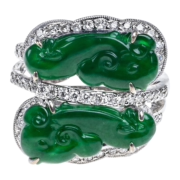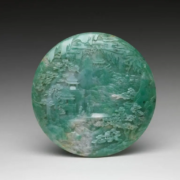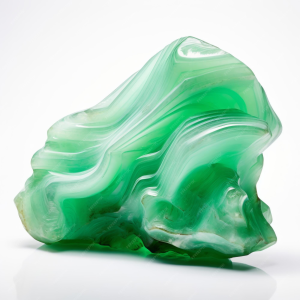Classification and grading of jadeite
Jadeite classification and grading systems vary depending on whether you’re looking at gemological standards (scientific properties) or trade standards (market categories). I’ll give you both perspectives so it’s clear.
1. Gemological Classification of Jadeite
From a scientific standpoint, jadeite is graded according to its composition, transparency, texture, and color.
A. By Composition / Authenticity
- Type A Jadeite – 100% natural jadeite, only polished with wax. No bleaching, no dyeing, no polymer impregnation.
- Type B Jadeite – Bleached in acid to remove impurities, then impregnated with polymer resin to improve transparency and stability. No artificial coloring.
- Type C Jadeite – Dyed or stained to enhance color (often green or lavender).
- Type B+C – Both polymer impregnation and dyeing.
- Type D – Jadeite doublets/triplets or composites (thin jade slice glued to another material).
B. By Color Quality
The “Three Primary Factors” for jadeite value are:
- Hue – Pure, vivid green is the most prized (“imperial green”). Lavender, icy white, and certain blue-greens are also valued.
- Tone – Medium tone is preferred; overly dark or pale jadeite loses vibrancy.
- Saturation – Strong, rich saturation increases value.
Common trade color names include:
- Imperial Green
- Apple Green
- Moss-in-Snow (white with green inclusions)
- Icy Jade (translucent white/near-colorless)
- Lavender Jade
C. By Transparency
Transparency directly affects the liveliness and “water” of jadeite:
- High – “Glass” or “Ice” grade (semi-transparent to transparent)
- Medium – Translucent (“water” jade)
- Low – Opaque (“bean” jade, “porcelain” jade)
D. By Texture (Grain Size)
Finer grain = smoother polish, higher value:
- Fine grain – “Glass” texture, smooth and bright
- Medium grain – Slightly coarse under magnification
- Coarse grain – Grainy, dull luster
2. Trade Grading Systems
Many jade markets (Myanmar, Hong Kong, Mainland China, Taiwan) use combined grading, weighing authenticity, color, texture, and transparency.
A typical Chinese grading scale:
- Top Grade – Fine texture, vivid pure hue, high transparency (“glass” jade)
- Grade A – Good texture, bright color, translucent
- Grade B – Medium texture, uneven color, moderate transparency
- Grade C – Poor texture, dull color, opaque
3. Certification
Reputable labs (e.g., NGTC, GIA, HKJSL) will issue reports confirming:
- Material: Natural jadeite jade
- Treatment: Untreated / polymer impregnated / dyed
- Quality Notes: Transparency, color, texture
✅ Key takeaway:
The most valuable jadeite is Type A, imperial green, fine texture, high transparency, vivid saturation, with no treatment.



Leave a Reply
Want to join the discussion?Feel free to contribute!